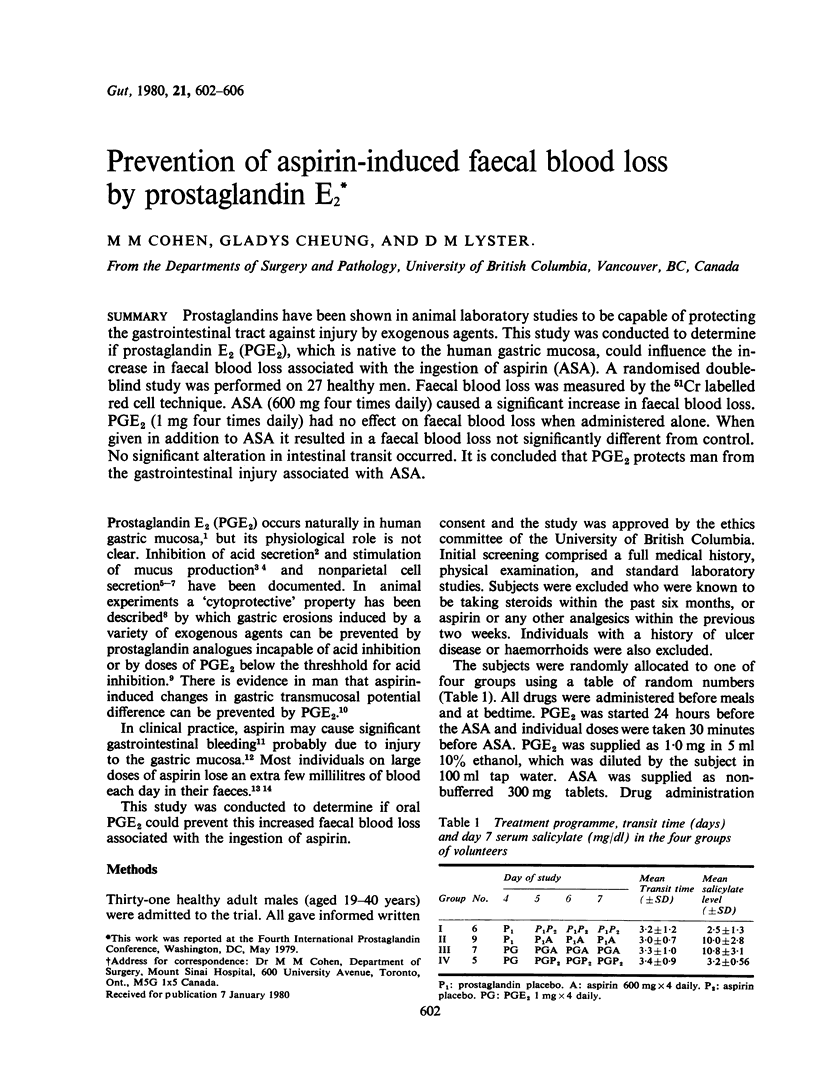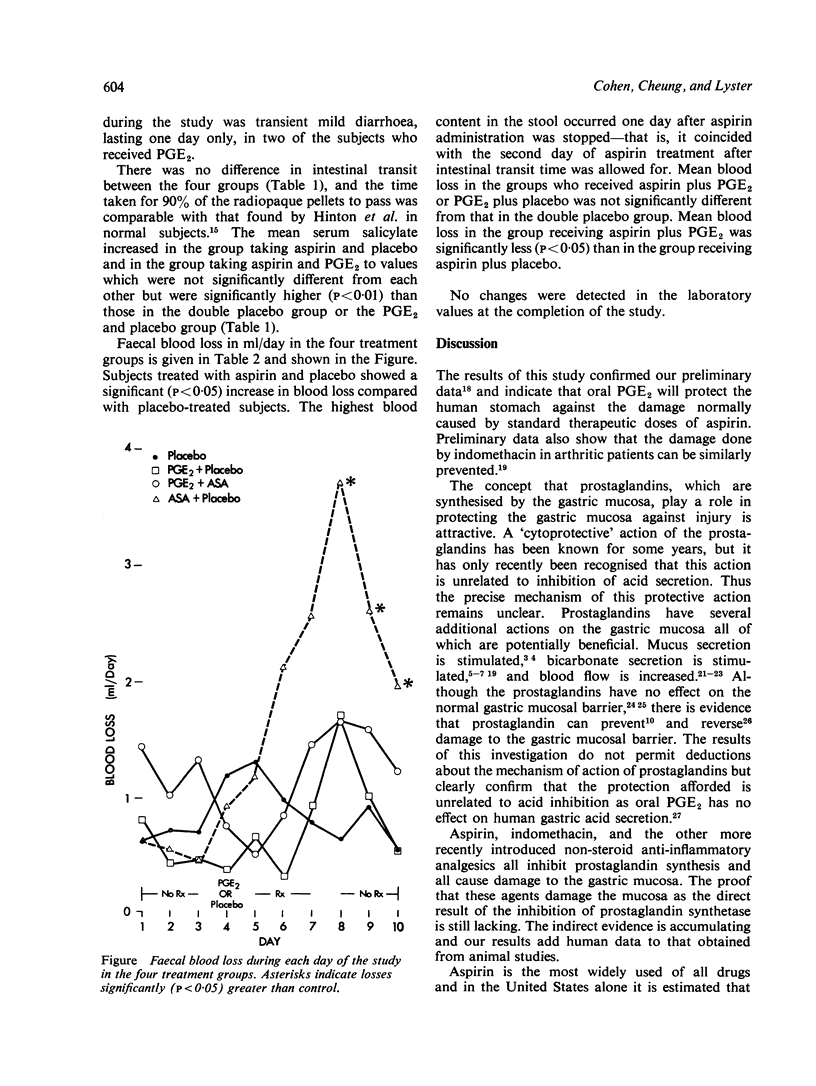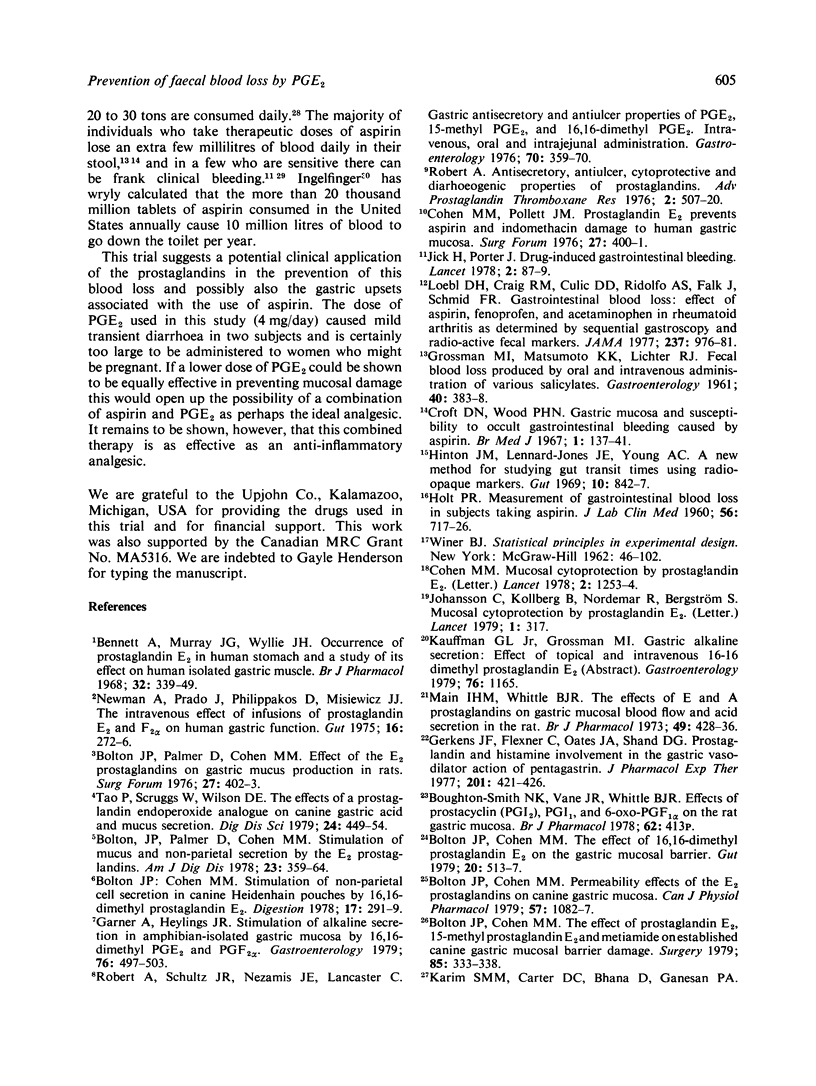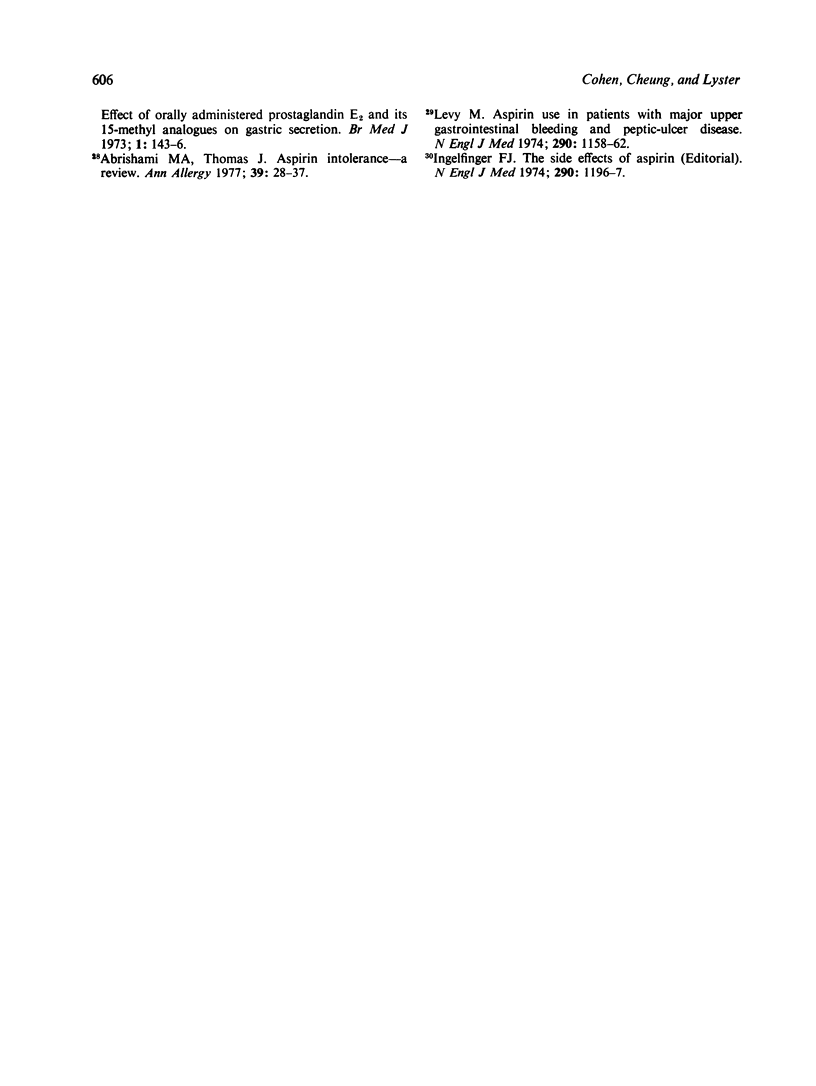Abstract
Prostaglandins have been shown in animal laboratory studies to be capable of protecting the gastrointestinal tract against injury by exogenous agents. This study was conducted to determine if prostaglandin E2 (PGE2), which is native to the human gastric mucosa, could influence the increase in faecal blood loss associated with the ingestion of aspirin (ASA). A randomised double-blind study was performed on 27 healthy men. Faecal blood loss was measured by the 51Cr labelled red cell technique. ASA (600 mg four times daily) caused a significant increase in faecal blood loss. PGE2 (1 mg four times daily) had no effect on faecal blood loss when administered alone. When given in addition to ASA it resulted in a faecal blood loss not significantly different from control. No significant alteration in intestinal transit occurred. It is concluded that PGE2 protects man from the gastrointestinal injury associated with ASA.
Full text
PDF




Selected References
These references are in PubMed. This may not be the complete list of references from this article.
- Abrishami M. A., Thomas J. Aspirin intolerance--a review. Ann Allergy. 1977 Jul;39(1):28–37. [PubMed] [Google Scholar]
- Bennett A., Murray J. G., Wyllie J. H. Occurrence of prostaglandin E2 in the human stomach, and a study of its effects on human isolated gastric muscle. Br J Pharmacol Chemother. 1968 Feb;32(2):339–349. [PubMed] [Google Scholar]
- Bolton J. P., Cohen M. M. Effect of 16,16-dimethyl prostaglandin E2 on the gastric mucosal barrier. Gut. 1979 Jun;20(6):513–517. doi: 10.1136/gut.20.6.513. [DOI] [PMC free article] [PubMed] [Google Scholar]
- Bolton J. P., Cohen M. M. Permeability effects of the E2 prostaglandins on canine gastric mucosa. Can J Physiol Pharmacol. 1979 Oct;57(10):1082–1087. doi: 10.1139/y79-162. [DOI] [PubMed] [Google Scholar]
- Bolton J. P., Cohen M. M. Stimulation of non-parietal cell secretion in canine Heidenhain pouches by 16,16-dimethyl prostaglandin E2. Digestion. 1978 Jul-Aug;17(4):291–299. doi: 10.1159/000198122. [DOI] [PubMed] [Google Scholar]
- Bolton J. P., Cohen M. M. The effect of prostaglandin E2, 15-methyl prostaglandin E2, and metiamide on established canine gastric mucosal barrier damage. Surgery. 1979 Mar;85(3):333–338. [PubMed] [Google Scholar]
- Bolton J. P., Palmer D., Cohen M. M. Effect of the E2 prostaglandins on gastric mucus production in rats. Surg Forum. 1976;27(62):402–403. [PubMed] [Google Scholar]
- Bolton J. P., Palmer D., Cohen M. M. Stimulation of mucus and nonparietal cell secretion by the E2 prostaglandins. Am J Dig Dis. 1978 Apr;23(4):359–364. doi: 10.1007/BF01072421. [DOI] [PubMed] [Google Scholar]
- Boughton-Smith N. K., Vane J. R., Whittle B. J. Effects of prostacyclin (PGI2), PGI1 and 6-oxo-PGF1alpha on the rat gastric mucosa [proceedings]. Br J Pharmacol. 1978 Mar;62(3):413P–413P. [PMC free article] [PubMed] [Google Scholar]
- Cohen M. M. Mucosal cytoprotection by prostaglandin E2. Lancet. 1978 Dec 9;2(8102):1253–1254. doi: 10.1016/s0140-6736(78)92124-4. [DOI] [PubMed] [Google Scholar]
- Cohen M. M., Pollett J. M. Prostaglandin E2 prevents aspirin and indomethacin damage to human gastric mucosa. Surg Forum. 1976;27(62):400–401. [PubMed] [Google Scholar]
- Croft D. N., Wood P. H. Gastric mucosa and susceptibility to occult gastrointestinal bleeding caused by aspirin. Br Med J. 1967 Jan 21;1(5533):137–141. doi: 10.1136/bmj.1.5533.137. [DOI] [PMC free article] [PubMed] [Google Scholar]
- GROSSMAN M. I., MATSUMOTO K. K., LICHTER R. J. Fecal blood loss produced by oral and intravenous administration of various salicylates. Gastroenterology. 1961 Mar;40:383–388. [PubMed] [Google Scholar]
- Garner A., Heylings J. R. Stimulation of alkaline secretion in amphibian-isolated gastric mucosa by 16,16-dimethyl PGE2 and PGF2 alpha. A proposed explanation for some of the cytoprotective actions of prostaglandins. Gastroenterology. 1979 Mar;76(3):497–503. [PubMed] [Google Scholar]
- Gerkens J. F., Flexner C., Oates J. A., Shand D. G. Prostaglandin and histamine involvement in the gastric vasodilator action of pentagastrin. J Pharmacol Exp Ther. 1977 May;201(2):421–426. [PubMed] [Google Scholar]
- Hinton J. M., Lennard-Jones J. E., Young A. C. A ne method for studying gut transit times using radioopaque markers. Gut. 1969 Oct;10(10):842–847. doi: 10.1136/gut.10.10.842. [DOI] [PMC free article] [PubMed] [Google Scholar]
- Ingelfinger F. J. Editorial: The side effects of aspirin. N Engl J Med. 1974 May 23;290(21):1196–1197. doi: 10.1056/NEJM197405232902111. [DOI] [PubMed] [Google Scholar]
- Jick H., Porter J. Drug-induced gastrointestinal bleeding. Report from the Boston Collaborative Drug Surveillance Program, Boston University Medical Center. Lancet. 1978 Jul 8;2(8080):87–89. doi: 10.1016/s0140-6736(78)91396-x. [DOI] [PubMed] [Google Scholar]
- Johansson C., Kollberg B., Nordemar R., Bergström S. Mucosal protection by prostaglandin E2. Lancet. 1979 Feb 10;1(8111):317–317. doi: 10.1016/s0140-6736(79)90723-2. [DOI] [PubMed] [Google Scholar]
- Karim S. M., Carter D. C., Bhana D., Ganesan P. A. Effect of orally administered prostaglandin E 2 and its 15-methyl analogues on gastric secretion. Br Med J. 1973 Jan 20;1(5846):143–146. doi: 10.1136/bmj.1.5846.143. [DOI] [PMC free article] [PubMed] [Google Scholar]
- Levy M. Aspirin use in patients with major upper gastrointestinal bleeding and peptic-ulcer disease. A report from the Boston Collaborative Drug Surveillance Program, Boston University Medical Center. N Engl J Med. 1974 May 23;290(21):1158–1162. doi: 10.1056/NEJM197405232902102. [DOI] [PubMed] [Google Scholar]
- Loebl D. H., Craig R. M., Culic D. D., Ridolfo A. S., Falk J., Schmid F. R. Gastrointestinal blood loss. Effect of aspirin, fenoprofen, and acetaminophen in rheumatoid arthritis as determined by sequential gastroscopy and radioactive fecal markers. JAMA. 1977 Mar 7;237(10):976–981. doi: 10.1001/jama.237.10.976. [DOI] [PubMed] [Google Scholar]
- Main I. H., Whittle B. J. The effects E and A prostaglandins on gastric mucosal blood flow and acid secretion in the rat. Br J Pharmacol. 1973 Nov;49(3):428–436. doi: 10.1111/j.1476-5381.1973.tb17253.x. [DOI] [PMC free article] [PubMed] [Google Scholar]
- Newman A., de Moraes-Filho J. P., Philippakos D., Misiewicz J. J. The effect of intravenous infusions of prostaglandins E-2 and F-2alpha on human gastric function. Gut. 1975 Apr;16(4):272–276. doi: 10.1136/gut.16.4.272. [DOI] [PMC free article] [PubMed] [Google Scholar]
- Robert A. Antisecretory, antiulcer, cytoprotective and diarrheogenic properties of prostaglandins. Adv Prostaglandin Thromboxane Res. 1976;2:507–520. [PubMed] [Google Scholar]
- Robert A., Schultz J. R., Nezamis J. E., Lancaster C. Gastric antisecretory and antiulcer properties of PGE2, 15-methyl PGE2, and 16, 16-dimethyl PGE2. Intravenous, oral and intrajejunal administration. Gastroenterology. 1976 Mar;70(3):359–370. [PubMed] [Google Scholar]
- Tao P., Scruggs W., Wilson D. E. The effects of a prostaglandin endoperoxide analogue on canine gastric acid and mucus secretion. Dig Dis Sci. 1979 Jun;24(6):449–454. doi: 10.1007/BF01299826. [DOI] [PubMed] [Google Scholar]


